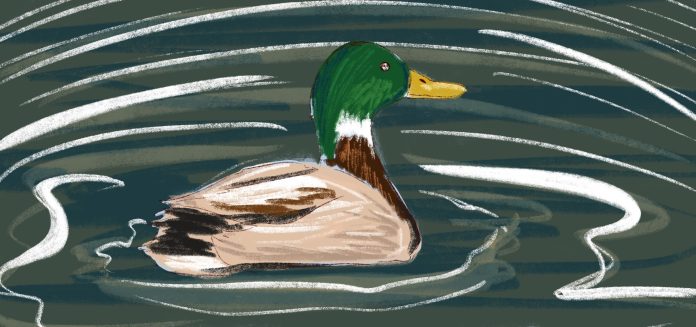Mine Ryu
Contributing Writer
Whether it be in the early morning or the late afternoon, one may catch sight of green-headed birds floating on the surface of the lagoon waters. These are the mallard duck, one of the most commonly sighted bird species in the whole Northern Hemisphere. Their unique and identifiable color patterns make them a familiar sight; coming across one in the UC Santa Barbara (UCSB) lagoon may feel like meeting an old friend.
The mallard duck is arguably one of the most commonly sighted bird species in America. Their size is roughly between a crow and a goose, making them quite large on average as a species. As is the case with many animals, there are highly distinguishing features between the males and females. The males, called drakes, are especially known for their green iridescent heads and yellow beaks, which greatly set them apart from the grayish-brown females. They also exhibit iridescent feathers as violet patches on the sides of their wings. This is the one feather that they share with the females.
Mallard duck populations are most abundant in freshwater habitats in not only North America, but also in Asian and European countries. They are found in locations such as ponds, rivers, marshes, lakes, and even saltwater wetlands. In these habitats, the ducks hunt for fish, amphibians, and aquatic plants by dipping their heads into the water or, rarely, by diving. They also sometimes come out of the water to graze on grass or grains on land.
During mating season, flocks of the mallard duck are seen migrating to the northern parts of their breeding ground to lay dozens of eggs. The groups entirely consist of mated pairs, though once the eggs are incubated (which takes about a month) the males make flocks of their own and abandon the nests. From here, it is up to the females to take care of their offspring.
One would guess that the abundance of the ducks would mean they are not in danger of direct extinction. However, hybridization has proved to be a substantial problem that threatens the populations of the ducks. Cases can be observed in Florida, where wild mallard duck populations stay until they migrate to the north for breeding season.
In their absence, domesticated ducks are released into local habitats, such as city ponds, to stay for the whole year. As a result, domesticated ducks have started to mate with ducks from the wild populations, with more hybrid ducks being observed in wild flocks and mated pairs, causing a decrease in the pure-bred mallard duck populations in Florida. If this problem persists, we may face the extinction of the mallard duck populations in Florida.
It is easy to take nature for granted, especially when it comes to abundant plants or animals. However, the mallard duck reminds us that there is beauty to observe and history to learn with any living species.











